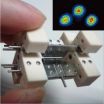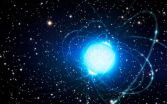(Press-News.org) The final step in the production of a biotech medicine is finishing with the correct sugar structure. This step is essential for the efficacy of the medicine, but it also makes the production process very complex and expensive. Leander Meuris, Francis Santens and Nico Callewaert (VIB/UGent) have developed a technology that shortens the sugar structures whilst retaining the therapeutic efficiency. This technology has the potential to make the production of biotech medicines significantly simpler and cheaper.
Sugar structures are essential for the mechanism of biotech medicines
Nearly all biotech medicines are proteins. Most of these medicines contain a mixture of complicated sugar structures that are attached to the protein. These sugars are important for the mechanism of the medicine on the one hand, but on the other hand their complicated structure also causes problems during production. This makes the process expensive and often results in a mixture of the same protein with different sugars attached. In some cases, only a few of the many sugar forms are ideal for the treatment and others are not, meaning that a part of the production and treatment efficiency is lost.
Optimizing production cells
The proteins that are used as biotech medicines are produced by living cells. Leander Meuris and Nico Callewaert have altered these production cells so that they truncate the sugar structures to a smaller shape. In order to achieve this they added an enzyme obtained from a fungus, which truncates complex sugars, to the production cells. The stump that remains after truncation is then expanded by the cells to form two similar structures that are very suitable for therapeutic applications. Surprisingly, these production cells do not mind: they grow perfectly and continue to produce the therapeutic proteins.
A satisfying discovery
Nico Callewaert (VIB/UGent): "This technology has allowed us to solve an old biotech problem. Since the 1990s, nearly everyone has been working to make the sugar synthesis in biotech production cells as similar to human cells as possible. This is a very difficult task, because there are so many steps in this synthesis pathway. We have been able to create a 'detour' in this synthesis pathway in a fairly simple manner, making the pathway much shorter and simpler."
Leander Meuris (VIB/UGent): "You can compare it to a pollard willow. The branches of willows are pruned to keep the tree more functional, just like our technology in which we removed the complex branches to make biotech medicines more manageable and in some cases more efficient."
INFORMATION: END
New technology simplifies production of biotech medicines
2014-05-14
ELSE PRESS RELEASES FROM THIS DATE:
@millennials wary of @twitter, #MSU study finds
2014-05-14
EAST LANSING, Mich. --- A new study indicates young adults have a healthy mistrust of the information they read on Twitter.
Nearly anyone can start a Twitter account and post 140 characters of information at a time, bogus or not, a fact the study's participants seemed to grasp, said Kimberly Fenn, assistant professor of psychology at Michigan State University.
"Our findings suggest young people are somewhat wary of information that comes from Twitter," said Fenn, lead investigator on the study. "It's a good sign."
The study, funded by the National Science Foundation, ...
Prevent premature deaths from heart failure, urges the Heart Failure Association
2014-05-14
Athens, 14 May 2014. The Heart Failure Association (HFA) of the European Society of Cardiology (ESC) is calling for global policy change relating to heart failure. An international white paper, Heart failure: preventing disease and death worldwide, will be presented at an endorsement event on 16 May 2014 in Athens, Greece, immediately before the Heart Failure 2014 Congress.
Approximately 15 million people are living with heart failure in Europe,1 and 26 million worldwide.2 The outlook is poor: survival rates are worse than those for bowel, breast or prostate cancer, and ...
Understanding the 1918 flu pandemic can aid in better infectious disease response
2014-05-14
COLUMBIA, Mo. – The 1918 Flu Pandemic infected over 500 million people, killing at least 50 million. Now, a researcher at the University of Missouri has analyzed the pandemic in two remote regions of North America, finding that despite their geographical divide, both regions had environmental, nutritional and economic factors that influenced morbidity during the pandemic. Findings from the research could help improve current health policies.
"Epidemics such as the Black Death in the 14th century, cholera in the 19th century and malaria have been documented and recorded ...
Tiny, tenacious and tentatively toxic
2014-05-14
COLLEGE STATION – Sometimes we think we know everything about something only to find out we really don't, said a Texas A&M University scientist.
Dr. Kevin Conway, assistant professor and curator of fishes with Texas A&M's department of wildlife and fisheries sciences at College Station, has published a paper documenting a new species of clingfish and a startling new discovery in a second well-documented clingfish.
Smithsonian Institution
The paper, entitled "Cryptic Diversity and Venom Glands in Western Atlantic Clingfishes of the Genus Acyrtus (Teleostei: Gobiesocidae)," ...
Chapman University affiliated physicist publishes on the Aharonov-Bohm effect in Nature
2014-05-14
ORANGE, Calif. – Chapman University affiliated quantum physicist Yutaka Shikano, Ph.D., has published a milestone paper in the prestigious journal Nature Communications. The title of the article is "Aharonov-Bohm effect with quantum tunneling in linear Paul trap." The Aharonov-Bohm (AB) effect was proposed by Yakir Aharonov, who is the co-director of the Institute for Quantum Studies at Chapman University, and David J. Bohm in 1959.
The AB effect showed for the first time that a magnetic field inside a confined region can have a measureable impact on a charged particle ...
Simplifying an ultrafast laser offers better control
2014-05-14
This news release is available in French. Going back to the drawing board to find a way to overcome the technical limitations of their laser, a team led by François Légaré, professor at the INRS Énergie Matériaux Télécommunications Research Centre, developed a new concept offering a simpler laser design, control over new parameters, and excellent performance potential. Called "frequency domain optical parametric amplification" (FOPA), the concept supersedes traditional time domain amplification schemes that have been the linchpin of ultrafast laser science for 20 years. ...
Magnetar formation mystery solved?
2014-05-14
When a massive star collapses under its own gravity during a supernova explosion it forms either a neutron star or black hole. Magnetars are an unusual and very exotic form of neutron star. Like all of these strange objects they are tiny and extraordinarily dense — a teaspoon of neutron star material would have a mass of about a billion tonnes — but they also have extremely powerful magnetic fields. Magnetar surfaces release vast quantities of gamma rays when they undergo a sudden adjustment known as a starquake as a result of the huge stresses in their crusts.
The Westerlund ...
Microchip-like technology allows single-cell analysis
2014-05-14
VIDEO:
This is a microscopic view of the new microchip-like technology sorting and storing magnetic particles in a three-by-three array.
Click here for more information.
DURHAM, N.C. -- A U.S. and Korean research team has developed a chip-like device that could be scaled up to sort and store hundreds of thousands of individual living cells in a matter of minutes. The system is similar to a random access memory chip, but it moves cells rather than electrons.
Researchers at ...
Using nature as a model for low-friction bearings
2014-05-14
Lubricants are required wherever moving parts come together. They prevent direct contact between solid elements and ensure that gears, bearings, and valves work as smoothly as possible. Depending on the application, the ideal lubricant must meet conflicting requirements. On the one hand, it should be as thin as possible because this reduces friction. On the other hand, it should be viscous enough that the lubricant stays in the contact gap. In practice, grease and oils are often used because their viscosity increases with pressure.
Biological lubrication in contrast is ...
Early menopause ups heart failure risk, especially for smokers
2014-05-14
CLEVELAND, Ohio (May 14, 2014)—Women who go through menopause early—at ages 40 to 45—have a higher rate of heart failure, according to a new study published online today in Menopause, the journal of The North American Menopause Society (NAMS). Smoking, current or past, raises the rate even more.
Research already pointed to a relationship between early menopause and heart disease—usually atherosclerotic heart disease. But this study from the Karolinska Institute in Stockholm, Sweden, is the first to demonstrate a link with heart failure, the inability of the heart to pump ...





